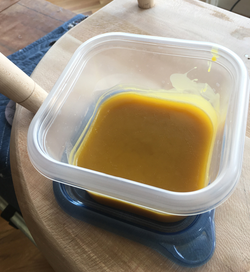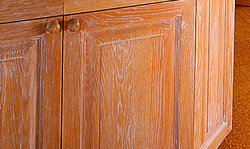Wax Recipes
Wax Finishes
The following is a list of wax finishes that I have found, most are historical recipes or redacted from historical sources, though have no references for these, they passed through my note-taking system so if I had them, they are lost. I have not experimented with any of them (yet).
Beeswax Paste Recipe
A basic wax recipe.
Ingredients:
- 8 oz 50% by weight Beeswax
- 8 oz 50% by volume Pure Turpentine (Not Turpentine Substitute or White Spirit)
- 1 oz Carnauba Wax (optional, this makes a much harder wax)
Process:
- Grate the Beeswax into a double boiler to melt.
- Add Carnauba Wax, stir well.
- Add Pure Turpentine, stir well.
- Remove from heat.
- Leave it for 24hrs to set.
Use: Use like any wax finish: rag on, wipe off, and buff.
Experience: I have not used this recipe.
Liming Wax
Liming wax is a way to simulate aging on wood by giving it a faded whitewash look. It is most effective on open-pore woods like oak.
Ingredients:
- 8 oz 46% by weight Beeswax
- 8 oz 46% by volume Pure Turpentine (Not Turpentine Substitute or White Spirit)
- 5 oz 8% by weight White Pigment (tiO2)
- 1 oz Carnauba Wax (optional, this makes a much harder wax)
Process:
- Grate the Beeswax into a double boiler.
- Add Carnauba Wax, stir well.
- Add Pure Turpentine, stir well.
- Add white Pigment stir well.
- Leave it for 24hrs to set
Use: To prepare an item of furniture for liming, sand the wood smooth and remove any traces of grease or dirt by wiping the surface with a cloth dipped in white spirits (mineral spirits/paint thinner).
Then, and usually, most woods and substrates will benefit from opening the grain with a wire brush or coarse paper. Using a clean wire brush, or coarse paper, scrub and travel on the wood or substrate in the direction of the grain, to clean out and to open the pores. Be careful not to be too aggressive. Check the progress quite regularly by glancing across the wood into the light, ensuring that there is a fairly even distribution of open pores. If required, apply the wood dye and seal the surface with a coat of thin transparent shellac.
Application: Apply sparingly with a cotton cloth or pad, rubbing well into the grain, rubbing across the grain, forcing the liming wax into the open grain and pores, and removing any excess. Dip the pad into the liming wax and then rub it into the grain, with circular overlapping strokes, until the surface is evenly covered. Again wipe across the grain with a clean pad, leaving the wax in the pores. This process is to ensure the liming is worked into the open pores and grain.
After about ten minutes, remove surplus wax from the surface by gently burnishing along the grain with a dry cotton cloth. The next day, apply an overcoat of clear Classic Wax for a more durable finish.
Experience: I have not used this recipe.
Furniture Cream Polish
Ingredients:
- 32 oz Pure Turpentine (Not Turpentine Substitute or White Spirit)
- 16 oz Boiled Linseed Oil
- 8 oz Beeswax
- 1 oz Carnauba Wax Flakes
Process:
- Grate the Beeswax into a double boiler.
- Add linseed oil, stir well.
- Add Pure Turpentine, stir well.
- Allow it to cool.
- If you did it right, it should be cream. If you had too much liquid and it's soupy, reheat, and add a little more wax, conversely, if it's hard, then and more liquid and reheat.
Use: Use like any wax finish: rag on, wipe off, and buff.
Experience: I have not used this recipe.

